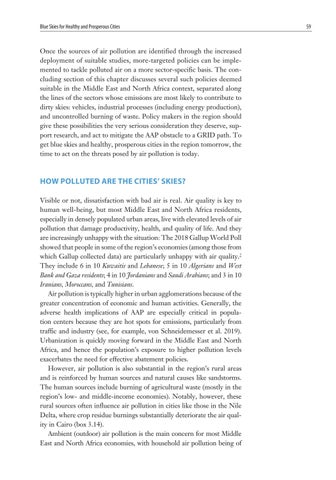Blue Skies for Healthy and Prosperous Cities
Once the sources of air pollution are identified through the increased deployment of suitable studies, more-targeted policies can be implemented to tackle polluted air on a more sector-specific basis. The concluding section of this chapter discusses several such policies deemed suitable in the Middle East and North Africa context, separated along the lines of the sectors whose emissions are most likely to contribute to dirty skies: vehicles, industrial processes (including energy production), and uncontrolled burning of waste. Policy makers in the region should give these possibilities the very serious consideration they deserve, support research, and act to mitigate the AAP obstacle to a GRID path. To get blue skies and healthy, prosperous cities in the region tomorrow, the time to act on the threats posed by air pollution is today.
HOW POLLUTED ARE THE CITIES’ SKIES? Visible or not, dissatisfaction with bad air is real. Air quality is key to human well-being, but most Middle East and North Africa residents, especially in densely populated urban areas, live with elevated levels of air pollution that damage productivity, health, and quality of life. And they are increasingly unhappy with the situation: The 2018 Gallup World Poll showed that people in some of the region’s economies (among those from which Gallup collected data) are particularly unhappy with air quality.2 They include 6 in 10 Kuwaitis and Lebanese; 5 in 10 Algerians and West Bank and Gaza residents; 4 in 10 Jordanians and Saudi Arabians; and 3 in 10 Iranians, Moroccans, and Tunisians. Air pollution is typically higher in urban agglomerations because of the greater concentration of economic and human activities. Generally, the adverse health implications of AAP are especially critical in population centers because they are hot spots for emissions, particularly from traffic and industry (see, for example, von Schneidemesser et al. 2019). Urbanization is quickly moving forward in the Middle East and North Africa, and hence the population’s exposure to higher pollution levels exacerbates the need for effective abatement policies. However, air pollution is also substantial in the region’s rural areas and is reinforced by human sources and natural causes like sandstorms. The human sources include burning of agricultural waste (mostly in the region’s low- and middle-income economies). Notably, however, these rural sources often influence air pollution in cities like those in the Nile Delta, where crop residue burnings substantially deteriorate the air quality in Cairo (box 3.14). Ambient (outdoor) air pollution is the main concern for most Middle East and North Africa economies, with household air pollution being of
59






